The Impact of UV Grow Lights on Agriculture
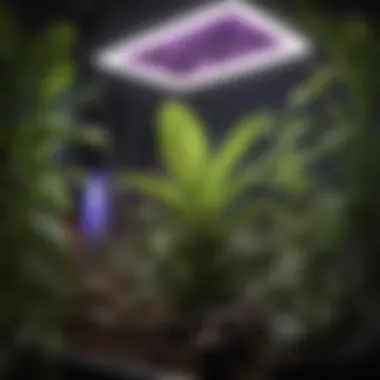
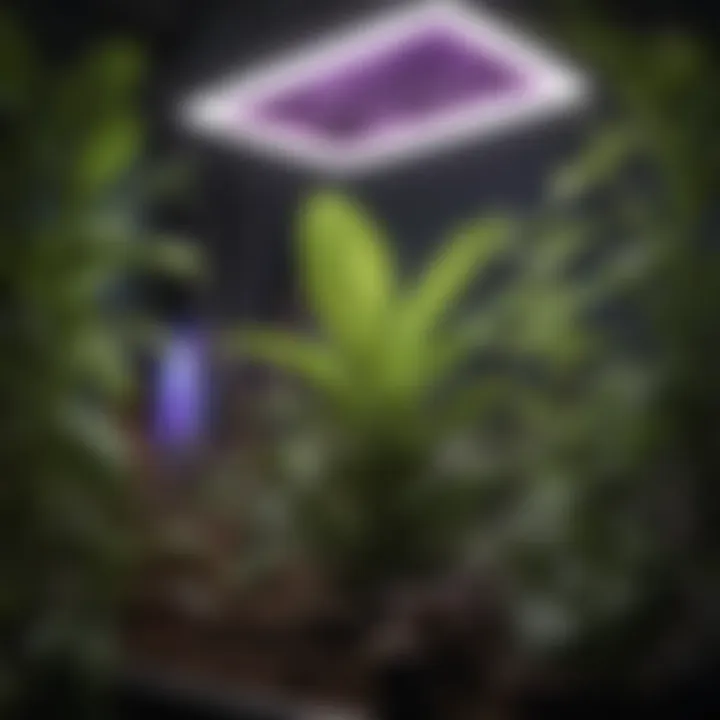
Overview of the Topic
Definition and Importance
Ultraviolet (UV) grow lights refer to a specific range of electromagnetic radiation that is often utilized in indoor farming and greenhouse settings. This light spectrum is not visible to human eyes but plays a critical role in the photosynthesis process, influencing plant growth and development. The importance of these lights lies in their ability to recreate natural sunlight conditions, which are crucial in regulated environments where traditional sunlight may be insufficient.
The integration of UV grow lights has become increasingly important as agriculture seeks to optimize yields and enhance crop quality. With the rising global population and the corresponding demand for food, employing advanced lighting technologies allows for year-round cultivation, enhancing nutritional content and growth rates of various plant species.
Current Trends
Currently, there is growing interest in the adoption of UV grow lights among agricultural professionals. This trend is driven by technological advancements, decreasing costs, and a better understanding of the benefits associated with UV radiation. Many farmers are leveraging these lights in combination with other growth-promoting technologies, such as hydroponics and aeroponics.
In addition to improving crop yields, UV grow lights are being explored for their potential to enhance plant resilience against pests and diseases. Research indicates that certain wavelengths of UV light can trigger the production of protective compounds in plants, providing a form of stress-induced defense that can ultimately lead to healthier crops.
Key Techniques and Practices
Step-by-Step Guide
To efficiently incorporate UV grow lights in cultivation practices, one can follow these essential steps:
- Determine the Need: Assess the specific plants being grown and their light requirements. Different species react differently to UV light, so understanding each one's needs is crucial.
- Choose the Right Type of UV Light: There are several types available, including UVC for sterilization, UVB for stimulating growth and enhancing flavor, and UVA, which tends to promote broader growth. Select the appropriate type based on the desired outcome.
- Set the Right Duration and Intensity: Carefully monitor and manage the intensity and duration of UV light exposure. Overexposure can harm plants. Most growers recommend an exposure period of around 15 to 30 minutes per day, tailored to the specific light sensitivity of plant types.
- Monitor Plant Response: Regularly observe plant health and growth patterns. Adjust light exposure based on the plants' visual cues and growth metrics.
Tools and Equipment Needed
Utilizing UV grow lights effectively requires specific tools and equipment:
- UV Grow Lights: Brands like Philips and GE offer diverse UV light options tailored for horticultural use.
- Light Meters: These devices help in monitoring UV intensity and ensuring optimal exposure levels.
- Thermometers and Hygrometers: Maintain ideal growing conditions with these additional tools that monitor temperature and humidity factors.
- Reflectors: To enhance light distribution, proper reflectors can increase the efficiency of UV lights across the growing area.
Challenges and Solutions
Common Obstacles
While UV grow lights offer numerous benefits, there are challenges in their application:
- Risk of Overexposure: Miscalculating light durations can lead to plant damage.
- Cost of Initial Setup: Many UV lighting systems can be expensive, leading to hesitation among small-scale farmers.
- Limited Research: More scientific studies are required to understand the long-term effects of UV light on various crops thoroughly.
Innovative Solutions
To tackle these issues, the following solutions might be considered:
- Education and Training: Providing workshops and smart resources can educate farmers about managing UV light use correctly.
- Gradual Investments: Small-scale farmers can opt for gradual implementation of UV technology rather than large upfront purchases.
- Collaborative Research: Partnerships between agricultural institutions and tech companies can enhance research on UV effects in diverse plant species.
In summary, UV grow lights present both opportunities and challenges for modern agriculture, aiming to bridge the gap between nutrient necessity and innovative farming practices.
Thus, understanding both the science and application of these lights can lead to more resilient and productive agricultural systems.
Foreword to Ultraviolet Grow Lights
Ultraviolet (UV) grow lights represent an advanced avenue in modern agriculture, particularly in controlled environments. The vitality of this topic lies in understanding how UV light influences plant growth, increases resilience, and optimizes productivity. As agricultural practices evolve, integrating UV grow lights offers numerous advantages while also presenting some considerations that must be addressed.
Definition and Importance
Ultraviolet grow lights are artificial light sources that emit UV radiation, part of the electromagnetic spectrum. They are pivotal in augmenting the natural light conditions under which plants grow. This specific light helps in processes like photosynthesis and can trigger certain beneficial responses in plants, such as increased stress tolerance and better nutrient uptake. In practical terms, the importance of these grow lights lies in their ability to enhance the growth of various plants in a controlled manner, allowing for agricultural practices that are less reliant on natural sunlight, weather patterns, and seasonal changes.
Furthermore, UV grow lights support the cultivation of plants indoors or in greenhouse settings. They provide a steady source of illumination, which is crucial for year-round agriculture. Given that traditional farming can be quite limiting due to seasonal variances, these technologies present a solution to maximize crop yields.
History of Agricultural Lighting
The evolution of agricultural lighting is a fascinating journey. Initially, sunlight was the natural choice for growth. As early as the late 19th century, farmers and researchers began experimenting with the use of gas lamps to extend the daylight hours. The introduction of electric lights in the early 20th century brought more options, leading to the development of fluorescent lights.
By the 1980s, interest in specific light wavelengths gained traction within the agricultural community. This interest paved the way for the adoption of specialized lighting solutions, including UV lights. Today, with ongoing advances in technology, UV grow lights have become more accessible and efficient, revolutionizing the way plants are cultivated.
"Understanding the historical context of agricultural lighting underscores how far we've come. From gas lamps to sophisticated UV technology, each step has played a role in shaping modern agriculture."
In summary, UV grow lights are more than a supplementary tool; they represent a significant shift in agricultural techniques, providing sustainable options for farmers and enthusiasts. By grasping the definition, importance, and historical evolution of these lighting solutions, one can appreciate their vital role in modern agricultural practices.
Understanding Ultraviolet Light
Understanding ultraviolet light is crucial for grasping how its properties can enhance modern agricultural practices. Ultraviolet light, a segment of the electromagnetic spectrum, plays an essential role in influencing plant growth, development, and overall productivity. This understanding enables farmers and enthusiasts to optimize their use of UV grow lights in various settings, from indoor gardens to large-scale greenhouses.
The Electromagnetic Spectrum
The electromagnetic spectrum encompasses all types of electromagnetic radiation, which includes various wavelengths, from radio waves to gamma rays. Ultraviolet light sits between visible light and X-rays in this spectrum. Its wavelengths range from about 10 to 400 nanometers. Understanding where UV light falls within this spectrum helps in comprehending its energy and impact on plant biology.
In agriculture, the most relevant sections of the electromagnetic spectrum are visible light (400-700 nanometers) and ultraviolet light. By leveraging the correct wavelengths of UV light, plants can potentially experience improved growth rates, enhanced pigmentation, and increased resilience against pests and disease.
Types of Ultraviolet Light
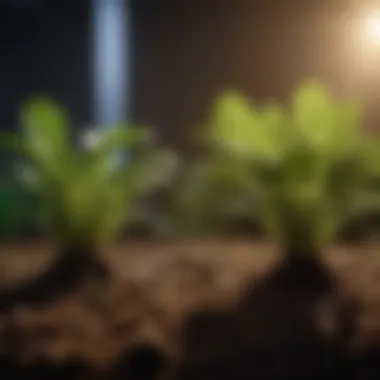
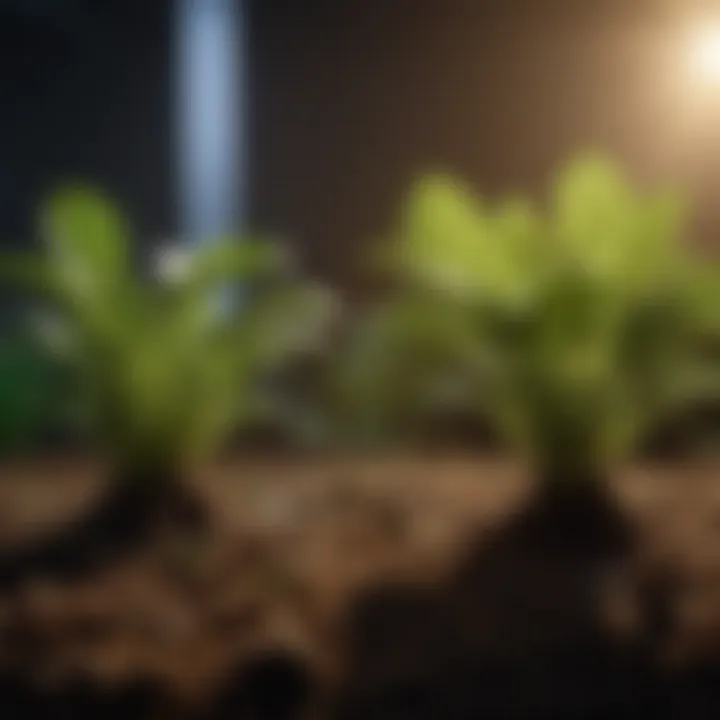
Ultraviolet light can be categorized into three primary types: UVA, UVB, and UVC, each with its characteristics and effects on plants. Understanding these types can help in selecting the most suitable light for specific cultivation needs.
UVA
UVA light has a wavelength range from 320 to 400 nanometers. It is the weakest type of UV radiation but constitutes about 95% of the UV light that reaches the Earth’s surface. This type of light is important because it penetrates deeper into plant tissues, stimulating vital processes like photosynthesis.
The key characteristic of UVA is its ability to support the development of secondary metabolites, such as flavonoids and anthocyanins. These compounds not only contribute to the color of plants but also offer protection against UV-induced damage. For many growers, its beneficial aspect is its capability to enhance plant quality without causing significant stress. However, excessive UVA can lead to photodamage if not balanced with other light types.
UVB
UVB light falls within the 280 to 320 nanometer range. It is more energetic than UVA and has significant effects on plant physiology. One notable key characteristic of UVB is its role in triggering the production of protective compounds, increasing resistance to pests and diseases. This makes it a popular choice for growers seeking to enhance the robustness of their crops.
A unique feature of UVB is its necessity for cannabis cultivation; it promotes resin production, which is crucial for various cannabis strains. Still, the disadvantage lies in its potential for causing sunburn and other stress if exposure is not carefully managed, especially in sensitive plants.
UVC
UVC radiation ranges from 100 to 280 nanometers. This light type is germicidal, meaning it can kill bacteria and mold, making it valuable in both agricultural and commercial settings for sterilization. However, while it has applications within grow environments to sanitize, exposure to plants is limited as it can cause significant cellular damage.
UVC is typically not used directly for plant growth but may be introduced for specific pest control applications. The key characteristic here is its potent antimicrobial properties. Disadvantages include the risk of harming plants and the necessity for protective gear when managing UVC systems.
"Optimizing the balance of UVA, UVB, and UVC in agricultural lighting systems can significantly enhance crop health and production."
In closing, understanding the types of ultraviolet light offers valuable insights for modern agriculture. Each type has distinct properties that can influence plant growth in unique ways. This knowledge provides a foundation for growers looking to leverage UV lighting for enhanced agricultural practices.
Mechanisms of Plant Growth
Understanding the mechanisms of plant growth is crucial for optimizing agricultural practices, especially with the advent of innovative technologies like ultraviolet grow lights. This section explores how UV light interacts with essential growth processes. By delving into photosynthesis and the role of plant hormones, it is possible to unveil the intricate ways UV light influences plant development.
Photosynthesis and Light Requirements
Photosynthesis is the foundation of plant growth. It is the process through which plants convert light energy into chemical energy. This conversion takes place primarily in chloroplasts. Plants require specific light wavelengths to efficiently perform this process. Sunlight is made up of various wavelengths but only a portion is useful for photosynthesis.
Ultraviolet light, despite being outside the visible spectrum, can still have a significant impact on this process. Purple wavelengths can enhance the efficiency of photosynthesis under the right conditions. Additionally, UV light may increase the production of protective compounds, such as flavonoids. These compounds help to shield plants from overexposure to damaging light.
Some key points about photosynthesis and its light requirements include:
- Light Spectrum: Plants utilize mainly blue and red light for photosynthesis. However, UV light can supplement these wavelengths.
- Intensity: Balance is crucial. Excessive UV exposure can hinder photosynthesis, while controlled exposure may optimize growth.
- Adaptation: Over time, plants have adapted to various light conditions. Using grow lights that replicate natural light can aid in this adaptation.
"The right light can transform growth patterns and enhance plant health significantly."
Plant Hormones and Growth Responses
Plant hormones, also known as phytohormones, are vital to the growth and development of plants. They regulate various functions, such as cell division, elongation, and responses to environmental cues. UV light can influence the production of these hormones, thereby affecting growth responsiveness.
Specifically, UV light exposure can stimulate the increase of certain hormones like auxins and gibberellins. These hormones aid in growth processes such as elongation and flowering. Understanding this interaction is essential for maximizing the benefits of ultraviolet grow lights.
Some notable aspects regarding plant hormones include:
- Auxins: Promote cell elongation and are crucial for root development.
- Gibberellins: Stimulate stem elongation and flowering. Increased UV light can lead to higher concentrations.
- Stress Response: UV exposure serves as a stress factor that can activate defensive mechanisms in plants as well, influencing hormone distribution.
In summary, both photosynthesis and plant hormones are interlinked. The presence of ultraviolet light can significantly affect these mechanisms, highlighting its role in modern agricultural settings.
Effects of Ultraviolet Light on Plants
The integration of ultraviolet light in agriculture plays a crucial role in enhancing plant health and productivity. Understanding its effects helps in optimizing growth conditions and mitigating potential downsides. The dual nature of ultraviolet exposure necessitates careful consideration of both benefits and risks to harness its full potential in plant cultivation.
Positive Impact on Growth
Ultraviolet light can have several positive effects on plant growth. Firstly, it can promote the synthesis of specific plant compounds. Many plants respond to UV exposure by developing secondary metabolites, such as flavonoids and phenolics. These compounds can enhance the plants' natural defenses against pests and diseases. Increased levels of antioxidants result from this exposure, providing not only benefits to the plants but also enriching the nutritional quality of the crops.
Additionally, UV light can improve the overall photosynthetic efficiency of plants. When plants experience UV radiation, they often adapt their leaf structure to better capture light, which can lead to enhanced growth rates. Plants like tomatoes and peppers have shown notable growth improvements under controlled UV light conditions.
Another aspect worth noting is the influence of UV light in flowering and fruit development. Certain plants develop flowers and fruits better when exposed to UV light, which can result in higher yields.
In summary, the positive impacts of UV light on growth explore plant physiological responses, enhancing productivity and resilience.
Potential Risks of Ultraviolet Exposure
While the benefits of UV light are significant, it is essential to acknowledge the potential risks associated with its exposure. Prolonged ultraviolet radiation can lead to various negative effects on plant health. One major concern is the possibility of UV-induced damage to plant tissues, particularly leaves. High doses can cause leaf burn and reduce photosynthetic capacity, ultimately hindering growth.
Moreover, different plant species respond variably to UV exposure. Some may thrive while others show signs of stress when subjected to even moderate UV light levels. As a result, careful monitoring and tailored light recipes become essential. Farmers must assess the specific needs of their crops regarding UV light integration.
Insects and microorganisms may also react to changes induced by UV light. Enhanced secondary metabolites can attract certain beneficial insects, but they may also draw pests. Finding the right balance is crucial in a diverse growing environment.
Types of Ultraviolet Grow Lights
Understanding the various types of ultraviolet grow lights is vital for any agricultural professional or enthusiast looking to optimize plant cultivation. Each type offers unique benefits and challenges, which can significantly impact the growth and health of plants in controlled environments.
Fluorescent UV Lights
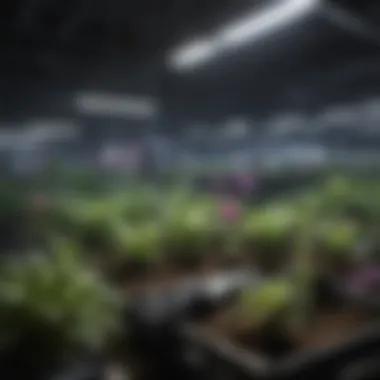

Fluorescent UV lights are commonly used in indoor gardening and commercial agriculture due to their effectiveness and lower energy consumption. They produce a balanced spectrum of light, including UV wavelengths in the UVA range, which can stimulate plant growth and enhance photosynthesis. These lights are typically available in different sizes and shapes, making them versatile for various growing setups.
Benefits of Fluorescent UV Lights:
- Cost-Effectiveness: They have a lower initial cost compared to other lighting types.
- Energy Efficiency: These lights use less electricity, thereby reducing operational costs.
- Low Heat Emission: They emit less heat, which lowers the risk of overheating plants.
Considerations:
While fluorescent lights are beneficial, they have limitations. Their effectiveness diminishes over time, requiring regular replacements. Additionally, they might not produce as much UVB light, which is crucial for certain plant species that require more intense UV exposure for optimal growth.
LED UV Lights
LED UV lights are rapidly gaining popularity in modern agriculture due to their advanced technology and efficiency. These lights can provide a full spectrum of light, including both UVA and UVB wavelengths, tailored for specific plants' needs. They have a long lifespan and are highly programmable, allowing growers to adjust light intensity and timing.
Benefits of LED UV Lights:
- Long Lifespan: LEDs can last up to 50,000 hours, reducing replacement frequency.
- Programmability: They can be customized for desired wavelengths, enhancing growth in specific plants.
- Energy Efficiency: LEDs consume significantly less power than traditional lighting options.
Considerations:
Despite their advantages, LED UV lights usually come with a higher initial cost. Also, not all LED lights produce sufficient UVB light for certain plant species. Therefore, careful selection is essential to meet specific horticultural needs.
High-Intensity Discharge (HID) Lights
HID lights have been a staple in large-scale agriculture. These lights, which include Metal Halide and High-Pressure Sodium lamps, provide intense light output and are effective in promoting vigorous plant growth. They are often used in commercial greenhouses and large indoor farms due to their ability to deliver significant light intensity.
Benefits of HID Lights:
- High Light Output: They produce a significant amount of light, ideal for large plants and extensive growing areas.
- Effective Plant Growth Stimulus: They can produce both UV and visible light, crucial for photosynthesis.
- Versatility: They can support a wide range of plant types and stages of growth.
Considerations:
The main downsides of HID lights include high energy consumption and significant heat production. Growers must implement cooling systems to maintain optimal plant temperatures, increasing overall energy costs. Regular bulb changes are also necessary to maintain effective light levels.
In summary, each type of ultraviolet grow light serves a distinct purpose in modern agriculture. Selecting the right light involves balancing cost, energy consumption, and plant growth requirements.
Understanding these differences will help growers make informed decisions that enhance productivity and plant health.
Applications of Ultraviolet Grow Lights
Ultraviolet grow lights are essential tools in modern agriculture, providing specific benefits that enhance plant growth, development, and overall yields. Their applications extend across various settings, which allows them to address specific growing needs and challenges. Understanding these applications offers agricultural professionals and enthusiasts valuable insights into optimizing plant cultivation.
Indoor Gardening and Hydroponics
Indoor gardening has grown significantly in popularity. The use of ultraviolet grow lights enables enthusiasts and professionals to cultivate plants in non-traditional settings. These lights allow for consistent growth regardless of outdoor conditions, meaning that plants can thrive year-round.
Key Benefits of UV Grow Lights in Indoor Gardening:
- Tailored Light Spectrum: Different plants require specific light wavelengths for optimal photosynthesis. UV lights can be adjusted to provide ideal conditions for a variety of plants.
- Space Efficiency: With limited room indoors, maximizing light efficiency is vital. Ultraviolet grow lights can be arranged in a way that promotes optimal growth even in confined spaces.
- Disease Resistance: Some studies indicate that appropriate UV exposure can enhance the plants' resistance to diseases and pests. This benefit can be especially crucial for urban gardeners who face unique environmental pressures.
"Indoor growers can create an atmosphere that mirrors optimal conditions found in nature, regardless of weather changes outside."
Greenhouses and Controlled Environments
The role of ultraviolet grow lights is equally significant in controlled environments such as greenhouses. These spaces allow for the manipulation of growing conditions to achieve maximum efficiency and productivity. By integrating UV grow lights, greenhouse operators can achieve superior results.
Advantages of UV Grow Lights in Greenhouses:
- Extended Growing Season: UV lighting can supplement natural sunlight, extending the growing season. This is particularly beneficial in regions with shorter daylight hours.
- Enhanced Plant Quality: Studies suggest that controlled UV exposure can improve the quality of fruits and vegetables, making them more appealing to consumers.
- Flexibility in Crop Management: Growers can adjust the intensity and timing of UV light exposure to suit various crop types and growth stages.
Choosing the Right Ultraviolet Grow Light
Choosing the right ultraviolet grow light is essential for optimizing plant growth and health. With the variety of options available today, understanding what to consider can greatly impact crop yields and sustainability. Each aspect, from wattage to light spectrum, presents unique benefits and considerations that can guide agricultural professionals and enthusiasts alike in their selection process.
Factors to Consider
Wattage
Wattage determines the energy consumption of grow lights, which directly affects operational costs and efficiency. It is vital to select a wattage level that matches the specific needs of the plants being cultivated. Higher wattage illuminates a larger area but may lead to increased electricity bills. On the other hand, lower wattage can save money, yet might not provide enough light for optimal growth.
Key characteristic to highlight here is that appropriate wattage ensures sufficient light penetration to the plant canopy.
- Advantages: Higher wattage can promote faster plant growth and flowering periods.
- Disadvantages: The potential for overheating and increased energy costs must be considered.
Light Spectrum
The light spectrum is another crucial factor when selecting UV grow lights. Different plants thrive under specific wavelengths, and understanding the light spectrum helps in maximizing photosynthesis. For instance, blue light supports vegetative growth, while red light encourages flowering.
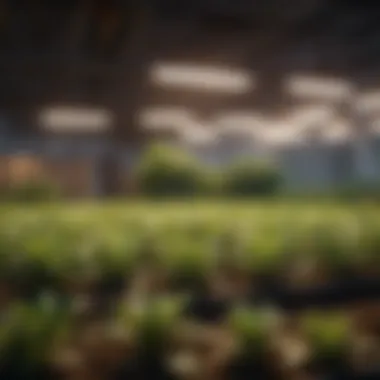

This aspect is essential as certain light spectra can enhance plant health overall. The added benefit of a balanced spectrum is that it reduces the stress plants may experience under certain lighting conditions.
- Advantages: Tailored spectrum setups can improve overall quality and yield.
- Disadvantages: Some lights are not versatile and may only cater to particular plant types.
Coverage Area
Coverage area refers to the total space that the grow light can effectively illuminate. It’s important to evaluate this parameter to avoid insufficient lighting in larger growing spaces. A light that cannot cover the required area can lead to uneven growth and the development of weak plants.
In addition, good coverage ensures that every plant receives adequate exposure to UV light, which is crucial for their development.
- Advantages: A wider coverage area can help maintain consistent light exposure across all plants.
- Disadvantages: Lights with a vast coverage may be costly, both in purchase and installation.
Cost Analysis and Budget Planning
When considering ultraviolet grow lights, a comprehensive cost analysis and budget planning are necessary. It involves comparing initial costs, operating expenses, and potential returns from better yields. Although higher-quality lights may demand significant upfront investment, they could lead to greater yields and crop quality in the long term.
Incorporating UV grow lights should be seen as an investment into agricultural practices. Plan for maintenance costs and consider energy efficiency to manage overall expenditure.
"Investing in the right ultraviolet grow light is essential for the success of modern agriculture. Understanding your options helps achieve optimal growth and quality for your crops."
By evaluating these elements, farmers and enthusiasts can make informed choices that align with their agricultural goals.
Maintenance of Ultraviolet Grow Lights
Effective maintenance of ultraviolet grow lights is crucial for ensuring optimal plant growth and energy efficiency in agricultural settings. Proper care can prolong the lifespan of these lighting systems, enhance their performance, and ensure that plants benefit maximally from the UV exposure.
Cleaning and Longevity
Regular cleaning of ultraviolet grow lights prevents the build-up of dust and grime, which can decrease light efficacy. When light sources are obscured, plants receive less UV radiation, which may hinder their growth. To effectively clean grow lights:
- Use a soft cloth or non-abrasive sponge to wipe down the surfaces, always with the lights turned off and cool to the touch.
- Avoid aggressive cleaning chemicals, as they can damage the finish or the glass of the lights. A mild soap solution is typically enough.
- Examine reflectors and lenses for residues that block light. Cleaning these components can significantly improve light penetration.
Performing regular maintenance checks helps to catch issues before they escalate. Longevity is also influenced by
- Proper cooling systems in place to prevent overheating, which can harm both the lights and the surrounding plants.
- Using timers and sensors to ensure lights operate only when needed reduces wear and tear while saving on energy costs.
Replacements and Upgrades
Knowing when to replace components of ultraviolet grow lights can dramatically alter the effectiveness of plant growth practices. Factors to consider when evaluating replacements include:
- Light output degradation: Over time, UV lights lose intensity. Regularly testing output can inform you when to replace bulbs or units.
- Technology advancements: The market continually evolves, offering more energy-efficient UV lights. Upgrading to LED UV systems can provide longer lifespans and lower energy demands compared to traditional options.
- Cost considerations: Evaluate the long-term replacement costs compared to projected gains in plant yield and health. Investing in higher-quality grow lights with an extended warranty may yield better return depending on your production goals.
In summary, careful maintenance of ultraviolet grow lights not only ensures extended tool usage but also optimizes plant health and productivity. Paying attention to both cleaning routines and replacement schedules is an essential part of an effective agricultural lighting strategy.
Regulatory and Safety Considerations
The discussion of ultraviolet (UV) grow lights in agriculture cannot overlook the significant regulatory and safety considerations involved. Ensuring safe use of UV technologies is essential for agriculture professionals aiming to maximize productivity while safeguarding both human health and the environment. Regulatory frameworks are often designed to mitigate health risks and uphold safety standards that benefit farmers, consumers, and even the broader ecosystem. Thus, understanding these regulations is crucial to incorporating UV grow lights effectively and responsibly.
UV Light Safety Precautions
UV light can produce both advantages and risks in agriculture. To ensure safety when using UV grow lights, farmers must adopt specific precautions:
- Personal Protective Equipment (PPE): Wearing suitable PPE, such as protective goggles and clothing, is essential during installation and operation of UV lights.
- Spatial Planning: Placing UV lights in a manner that limits exposure to bystanders is important. Designing layouts that restrict direct UV exposure can prevent unintended health effects.
- Educating Personnel: Workers should receive training about UV risks and safety measures. This knowledge will empower them to handle equipment safely and reduce exposure risks.
- Regular Monitoring: Employing UV monitoring devices can help track levels of ultraviolet light exposure in the work environment. This can ensure compliance with safety standards and mitigate potential hazards.
By prioritizing these precautions, agricultural professionals can effectively enhance plant growth while ensuring health and safety.
Understanding Regulations for Agricultural Use
Regulations on the use of UV lights in agriculture are influenced by multiple factors. Regulatory bodies aim to establish standards that balance productivity improvements with safety and environmental sustainability. Some key considerations include:
- Compliance Standards: Each country has specific regulations pertaining to the intensity and duration of UV exposure permissible for various applications. Adhering to these standards ensures safe usage.
- Health Impact Assessments: Many jurisdictions require evaluations of potential health risks associated with semiconductor UV light usage in agricultural settings. Conducting these assessments can guide responsible practices and protect worker health.
- Environmental Safeguards: Regulations also consider the potential ecological impacts, such as the effect on surrounding flora and fauna when using UV lights. Understanding these regulations helps protect biodiversity.
- Labeling and Transparency: Grow light manufacturers must provide clear labeling regarding their products' UV output and safety specifications, allowing agriculture professionals to make informed choices.
In summary, regulatory and safety considerations are integral to the responsible usage of ultraviolet grow lights. Following established safety precautions and complying with regulatory standards can significantly reduce risks while enhancing agricultural productivity effectively.
Future Trends in Ultraviolet Lighting
The future of ultraviolet lighting in agriculture is promising, marked by rapid improvements and innovative applications. These advancements not only help to enhance plant growth but also improve the sustainability of agricultural practices. As agriculture faces challenges such as climate change, resource limitations, and a growing global population, it becomes essential to harness every tool available. Ultraviolet grow lights are at the forefront of these developments, offering potential solutions to these pressing issues.
Technological Advancements and Innovations
Innovations in UV lighting technology are transforming how plants are cultivated. For instance, the development of LED UV lights has gained significant traction. These lights are energy-efficient and have a longer lifespan than traditional sources. They emit specific wavelengths that can optimize plant growth phases, thereby supporting healthier plants.
Another major advancement is the integration of smart technology. Devices can now monitor environmental conditions and adjust light output accordingly. This adaptive response leads to more precise light management and reduction of energy waste.
Furthermore, research in multi-spectral lighting shows promise in enhancing specific plant attributes such as flavor, color, and nutritional value. Scientists are exploring how tailored UV exposure can express desirable traits in food crops, making them more appealing and nutritious for consumers.
"Embracing technological advancements in UV lighting can lead to significant efficiency gains in agriculture, alongside improved crop quality and yield."
Potential Research Areas
The ongoing research into ultraviolet lighting is crucial for addressing both practical and theoretical inquiries in agricultural science. Some vital research areas include:
- Effects on Different Plant Species: Understanding how varying types of plants react to UV light can guide growers in optimizing their use of these lights, leading to tailored applications for diverse crops.
- Long-Term Exposure Studies: It's important to investigate the long-term effects of UV exposure on plant health. Research should focus on how continuous exposure influences growth patterns, pest resistance, and overall plant vitality.
- Integration with Other Technologies: Examining how UV lighting can synergistically work with hydroponics, aquaponics, and other modern farming techniques may further enhance production efficiency.
- Cost-Benefit Analysis: Understanding the financial impacts, including return on investment from UV lighting technology adoption, is essential for promoting its widespread use in agriculture.
In summary, the future for ultraviolet grow lights within modern agriculture appears to align closely with emerging trends in technology and research. Adopting these advancements not only aids in improving crop yields but also encourages innovative practices that can sustain future agricultural needs.



